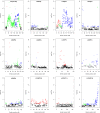Development of a SNP array and its application to genetic mapping and diversity assessment in pepper (Capsicum spp.)
- PMID: 27623541
- PMCID: PMC5020730
- DOI: 10.1038/srep33293
Development of a SNP array and its application to genetic mapping and diversity assessment in pepper (Capsicum spp.)
Abstract
The development and application of single nucleotide polymorphisms (SNPs) is in its infancy for pepper. Here, a set of 15,000 SNPs were chosen from the resequencing data to develop an array for pepper with 12,720 loci being ultimately synthesized. Of these, 8,199 (~64.46%) SNPs were found to be scorable and covered ~81.18% of the whole genome. With this array, a high-density interspecific genetic map with 5,569 SNPs was constructed using 297 F2 individuals, and genetic diversity of a panel of 399 pepper elite/landrace lines was successfully characterized. Based on the genetic map, one major QTL, named Up12.1, was detected for the fruit orientation trait. A total of 65 protein-coding genes were predicted within this QTL region based on the current annotation of the Zunla-1 genome. In summary, the thousands of well-validated SNP markers, high-density genetic map and genetic diversity information will be useful for molecular genetics and innovative breeding in pepper. Furthermore, the mapping results lay foundation for isolating the genes underlying variation in fruit orientation of Capsicum.
Figures





References
-
- Mongkolporn O. & Taylor P. J. Capsicum. In Wild Crop Relatives: Genomic and Breeding Resources10.1007/978-3-642-20450-0_4 (ed. Kole C.) 43–57 (Springer Berlin Heidelberg, 2011).
-
- Lefebvre V. Molecular Markers for Genetics and Breeding: Development and Use in Pepper (Capsicum spp.). in Molecular Marker Systems in Plant Breeding and Crop Improvement. Vol. 55 (eds Lörz H. & Wenzel G.) 189–214 (Springer Berlin Heidelberg, 2005).
Publication types
MeSH terms
LinkOut - more resources
Full Text Sources
Other Literature Sources
Miscellaneous

